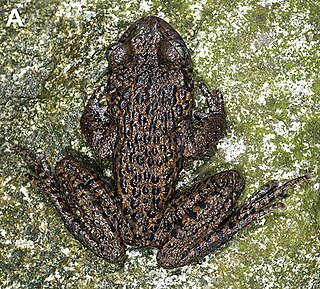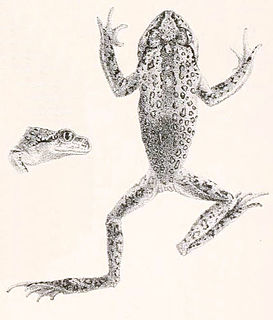
Salamandridae is a family of salamanders consisting of true salamanders and newts. Salamandrids are distinguished from other salamanders by the lack of rib or costal grooves along the sides of their bodies and by their rough skin. Their skin is very granular because of the number of poison glands. They also lack nasolabial grooves. Most species of Salamandridae have moveable eyelids but lack lacrimal glands.

The true frogs, family Ranidae, have the widest distribution of any frog family. They are abundant throughout most of the world, occurring on all continents except Antarctica. The true frogs are present in North America, northern South America, Europe, Africa, and Asia. The Asian range extends across the East Indies to New Guinea and a single species has spread into the far north of Australia.

The Asiatic salamanders are primitive salamanders found all over Asia, and in European Russia. They are closely related to the giant salamanders, with which they form the suborder Cryptobranchoidea. About half of hynobiids currently described are unique to Japan.

Karin Hills frog (Brachytarsophrys) is a genus of the family Megophryidae in the order Anura, and are found in southern China, Myanmar, northern Thailand and northern Vietnam.

Leptobrachella is a genus of frogs in the family Megophryidae. Members of Leptobrachella are found throughout Asia including on Borneo and the Natuna Islands. They are sometimes referred to as Borneo frogs, slender-armed frogs, or dwarf litter frogs. The genus contains over 80 species with 25 found in China alone.

Eastern spadefoot toads comprise a genus of the family Megophryidae in the order Anura, and are found in southern China, northeast India, Southeast Asia, and islands of the Sunda Shelf as well as the Philippines. They are characterized by a stocky body with slender, short hindlimbs. In identifying species, iris colour is a valuable diagnostic morphological characteristic ; the iris has uniform colour in some species, whereas in other species the upper half is coloured and the lower half is dark.

Theloderma, the bug-eyed frogs, mossy frogs or warty frogs, is a genus of frogs in the family Rhacophoridae, subfamily Rhacophorinae. They are found from northeastern India and southern China, through Southeast Asia, to the Greater Sunda Islands; the highest species richness is in Indochina. Some species, especially T. corticale, are sometimes kept in captivity.

Rhacophorus is a genus of frogs in the shrub frog family (Rhacophoridae)and the related Hylidae make up the true tree frogs. They are found in India, Japan, Madagascar, Africa, and Southeast Asia. Over 40 species are currently recognised.

Kurixalus is a genus of frogs in the family Rhacophoridae. The taxonomy of small rhacophids is difficult and has been subject to many revisions, but molecular genetic data do support monophyly of Kurixalus. These frogs are distributed from Himalayan front ranges of eastern India southward and eastward to Cambodia, Vietnam, southern China, Taiwan, and the Ryukyu Islands.

Leptolalax is a genus of frogs in the family Megophryidae. They are sometimes known as Asian toads, metacarpal-tubercled toads, or slender litter frogs, although many species-specific common names do not follow these conventions, and many species do not have common names. They are widely distributed in southeastern and eastern Asia, from southern China and northeastern India to the Malay Peninsula and Borneo. Leptolalax are typically small and have a cryptic colour pattern and no obvious morphological characters useful in systematic studies. Consequently, both molecular genetic analyses and analysis of advertisement calls by male frogs have been important in identifying new species.

Megophrys is a genus of frogs in the family Megophryidae. They occur in the mainland Southeastern Asia, the islands of the Sunda Shelf, and the Philippines. They commonly have elongated upper "eyebrows" and are thus known as Asian horned frogs.

Oreolalax is a genus of amphibian in the family Megophryidae. They are mostly endemic to southwestern China, with one species in northern Vietnam, and possibly extending into adjacent Laos. There is also a population in Arunachal Pradesh that has not yet been assigned to a species, although it might rather be a Scutiger.

Scutiger is a genus of toads in the family Megophryidae. Common name lazy toads has been coined for them. They occur in China, Burma, Nepal, and northern India in high-altitude habitats. Most are endemic to China.

Xenophrys is a genus of amphibians in the family Megophryidae. They are found in southeastern Asia to Borneo The genus has been found to be strongly polyphyletic, and awaiting a better solution, they have been included in the genus Megophrys. For the moment being, they are listed under their old genus in Wikipedia.

The frog family Dicroglossidae occurs in tropical and subtropical regions of Asia and Africa, with most genera and species being found in Asia. The common name of the family is fork-tongued frogs.

The Ceratobatrachidae are a family of frogs found in the Malay Peninsula, Borneo, the Philippines, Palau, Fiji, New Guinea, and the Admiralty, Bismarck, and Solomon Islands.

Quasipaa is a genus of frogs in the family Dicroglossidae. The genus has no established common name, but many individual species are referred to as spiny frogs. They occur in East and Southeast Asia, from Thailand and Cambodia to southern and eastern China.

Hebius is a genus of snakes in the family Colubridae.
Liurana is a genus of frogs in the family Ceratobatrachidae. It is the only genus in the subfamily Liuraninae.

















